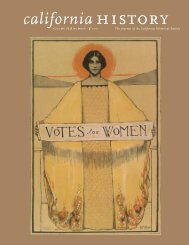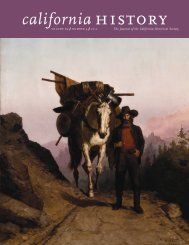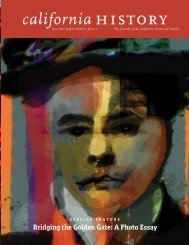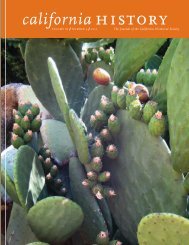Volume 90, Number 1 - California Historical Society
Volume 90, Number 1 - California Historical Society
Volume 90, Number 1 - California Historical Society
Create successful ePaper yourself
Turn your PDF publications into a flip-book with our unique Google optimized e-Paper software.
them. In a letter written to his family not long<br />
after he reached Monterey, Sully described her<br />
as “a tall majestic looking woman, about 30 or<br />
35, remarkably handsome . . . very agreeable, very<br />
good natured & very smart. In fact she is a well<br />
read woman & would grace any circle of society.”<br />
With her husband away temporarily and there<br />
“being no male in the house,” he added, “Me<br />
Madre (that is the name she calls herself though<br />
she is rather young & handsome to have so old<br />
a boy as me) requested me to make her house<br />
my home.” This might have been considered<br />
improper if she lived alone, but the house was<br />
brimming with servants and family members,<br />
including her eldest daughter, Manuela, who was<br />
fifteen and of marriageable age. Manuela was<br />
“remarkably pretty & gay,” he wrote, and “like all<br />
Spanish girls, monstrous fond of a flirtation. I<br />
fear she finds this rather a hard job with me, for<br />
my bad Spanish always sets her a laughing.” 6<br />
Sully was captivated by Manuela and eventually<br />
proposed marriage. But until he made his<br />
intentions clear he remained quite close to her<br />
mother, who served officially as godmother to<br />
many youngsters in <strong>California</strong> and continued in<br />
that capacity informally by taking Sully under her<br />
wing. She was only six years older than he was,<br />
and he at first found her a more congenial companion<br />
than Manuela, who struck him initially as<br />
too young and impulsive for an officer approaching<br />
thirty. In letters home, he mentioned the<br />
mother more often than the daughter and used<br />
language that caused family members to worry<br />
that he was straying into an affair. “Could I come<br />
across another Doña Angustias de la Guerra,” he<br />
wrote in August 1849, “I don’t think I would long<br />
be an old bachelor. She has given me a piece of<br />
gold from which I wish you to have made a ring.”<br />
To ease his family’s concerns, he later explained<br />
that he wanted the ring “to adorn my person &<br />
at the same time show my respect for the lady<br />
(who is by-the-by a married lady with 7 children).”<br />
There was, in fact, nothing improper in<br />
Angustias de la Guerra (1815–18<strong>90</strong>) sat for this portrait sometime<br />
after her marriage to Dr. James Ord in 1856. The daughter<br />
of José de la Guerra y Noriega (1779–1858), one of Mexican<br />
<strong>California</strong>’s leading figures, she told of her experiences in a diary<br />
she kept during the Mexican War and in a lengthy dictation to<br />
Thomas Savage, who interviewed her in 1878 while conducting<br />
research for Hubert Howe Bancroft’s multivolume History of<br />
<strong>California</strong>. Perhaps because the subject remained painful to her,<br />
she made little mention of her beloved daughter by her first marriage,<br />
Manuela Jimeno (1833–1851), who died ten months after<br />
wedding Alfred Sully without parental consent.<br />
<strong>California</strong> <strong>Historical</strong> <strong>Society</strong>, CHS2012.1014.tif<br />
his relationship with Angustias, but he was less<br />
than truthful when he claimed that he had “not<br />
yet seen anybody in this country good enough for<br />
me.” 7 Indeed, when later deprived of the company<br />
of Angustias and Manuela he found that<br />
they had been almost too kind and too good for<br />
him and left a void in his life that he found hard<br />
to fill.<br />
9









